Heckler & Koch G3
The Heckler & Koch G3 (Gewehr 3) is a 7.62×51mm NATO, select-fire battle rifle developed in the 1950s by the German armament manufacturer Heckler & Koch (H&K) in collaboration with the Spanish state-owned design and development agency CETME (Centro de Estudios Técnicos de Materiales Especiales).[2] The modular designed G3 has over the years been exported to over 70 countries and manufactured under licence in at least 15 countries, bringing the total number built to around 7,800,000.[3]
| G3 | |
|---|---|
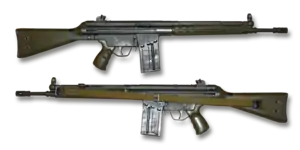 The AG-3, Norwegian made G3A5 variant of the G3 | |
| Type | Battle rifle |
| Place of origin | West Germany |
| Service history | |
| In service | 1959–present |
| Used by | See Users |
| Wars | See Conflicts |
| Production history | |
| Designer | CETME Mauser Heckler & Koch |
| Designed | 1950s |
| Manufacturer | Heckler & Koch (original) Rheinmetall MIC SEDENA Kongsberg Gruppen Pakistan Ordinance Factories and others |
| Produced | 1958–present |
| No. built | 8,000,000[1] |
| Variants | See Variants |
| Specifications | |
| Mass | 4.38 kg (9.66 lb) (G3A3) 4.7 kg (10 lb) (G3A4) |
| Length | 1,025 mm (40.4 in) |
| Barrel length | 450 mm (17.7 in) |
| Width | 45 mm (1.8 in) |
| Height | 220 mm (8.7 in) with inserted magazine |
| Cartridge | 7.62×51mm NATO |
| Action | Roller-delayed blowback |
| Rate of fire | 500–600 rounds/min |
| Muzzle velocity | 800 m/s (2,625 ft/s) |
| Effective firing range | 200–400 metres (219–437 yd) sight adjustments 600 metres (656 yd) with Fero Z24 telescopic sight |
| Maximum firing range | 3,700 metres (4,046 yd) |
| Feed system | 5-, 10-, 20-, 30-, or 40-round detachable box, and 50-round and 100-round drum magazine |
| Sights | Rear: rotary diopter; front: hooded post |
The G3 was the service rifle of the armed forces of Germany until it was replaced by the G36 in the 1990s.
History


The origin of the G3 can be traced back to the final years of World War II when Mauser engineers at the Light Weapon Development Group (Abteilung 37) at Oberndorf am Neckar designed the Maschinenkarabiner Gerät 06 (MKb Gerät 06, "machine carbine device 06") prototype assault rifle chambered for the intermediate 7.92×33mm Kurz cartridge, first with the Gerät 06 model using a roller-locked short recoil mechanism originally adapted from the MG 42 machine gun but with a fixed barrel and conventional gas-actuated piston rod.[4] With careful attention to the mechanical ratios, the gas system could be omitted.[5] The resultant weapon, Gerät 06H (the "H" suffix is an abbreviation for halbverriegelt - "half-locked") was assigned the designation StG 45(M) (Sturmgewehr 45(M) , assault rifle 45) but was not produced in significant numbers and the war ended before the first production rifles were completed.[6]
The German technicians involved in developing the StG 45(M) were taken to work in France at Centre d'Etudes et d'Armement de Mulhouse (CEAM). The StG 45(M) mechanism was modified by Ludwig Vorgrimler and Theodor Löffler at the Mulhouse facility between 1946 and 1949. Three versions were made, chambered in .30 Carbine, 7.92×33 mm Kurz, and the experimental 7.65×35 mm French short cartridge developed by Cartoucherie de Valence in 1948. A 7.5×38 mm cartridge using a partial aluminium bullet was abandoned in 1947. Löffler's design, designated Carabine Mitrailleuse Modèle 1950, was retained for trials among 12 different prototypes designed by CEAM, MAC, and MAS. Engaged in the Indochina War and being the second NATO contributor, France canceled the adoption of these new weapons for financial reasons.
_noBG.png.webp)
In 1950, Vorgrimler moved to Spain where he created the LV-50 rifle chambered for the Kurz cartridge and later, the proprietary 7.92×40mm CETME M53 round.[7] At this point, the rifle was renamed the Modelo 2. The Modelo 2 drew the attention of the West German Bundesgrenzschutz (Border Guards), who sought to re-equip the newly formed national defense forces. Not willing to accept a cartridge outside of the NATO specification, the Germans asked CETME to develop a 7.62×51mm version of the rifle. The resulting CETME Model A was chambered for the 7.62×51mm CETME cartridge which was identical in chamber dimensions but had a reduced-power load compared to the 7.62×51mm NATO round. Further development of the rifle with input from H&K produced the CETME Model B which received several modifications, including the ability to fire from a closed bolt in both semi-automatic and automatic firing modes, a new perforated sheet metal handguard (the folding bipod had been the foregrip in previous models), improved ergonomics and a slightly longer barrel with a 22 mm rifle grenade launcher guide. In 1958, this rifle was accepted into service with the Spanish Army as the Modelo 58, using the 7.62×51mm CETME round.
In 1956, the Bundesgrenzschutz canceled their planned procurement of the CETME rifles, adopting the Belgian-made FN FAL as the Gewehr 1 (G1) instead. However, the newly formed West German Army (Bundeswehr) now showed interest and soon purchased a number of CETME rifles (7.62×51mm NATO chambering) for further testing. The CETME, known as the Automatisches Gewehr G3 according to German nomenclature, competed successfully against the Swiss SIG SG 510 (G2) and the American AR-10 (G4) to replace the previously favored G1 rifle. In 1956 the Bundeswehr started extended troop trials with 400 CETME rifles. Heckler & Koch made a number of changes to the CETME rifles. In January 1959, the Bundeswehr officially adopted the technically improved CETME proposal.[3] The West German government wanted the G3 rifle to be produced under license in Germany; purchase of the G1 had previously fallen through over FN's refusal to grant such a license. In the case of the G3, the Dutch firm Nederlandse Wapen en Munitiefabriek (NWM) held production and sales rights to the CETME design outside of Spain. To acquire production rights, the West German government offered NWM contracts to supply the German Air Force (Luftwaffe) with 20mm ammunition. Production of the G3 was then assigned to Rheinmetall and Heckler & Koch.[8] The latter company already had ties to CETME, and had worked to further optimize the CETME rifle for use with the full-power 7.62×51mm NATO cartridge (as opposed to the downgraded CETME variant). In 1969, Rheinmetall gave up production rights to the G3 in exchange for Heckler & Koch's promise not to bid on MG 3 machine gun production. Later in 1977, the West German government ceded ownership of G3 production and sales rights exclusively to Heckler & Koch. After obtaining these rights, Heckler & Koch initially had to pay the government 4 Deutsche Marks per rifle, despite having been awarded the contract by the German government.
Initial production G3 rifles differed substantially from more recent models; early rifles featured closed-type mechanical flip-up sights (with two apertures), a lightweight folding bipod, a stamped sheet steel handguard, a wooden buttstock (in fixed stock models) or a telescopic metal stock.[7] Before delivery to the Bundeswehr, each G3 went through functional checks, zeroing the sight line (Anschießen) and a shooting test at the factory. In the process, five shots were fired at a target at 100 metres (109 yd) with particularly accurate sighting-in ammunition. The 5-shot group could not exceed 120 mm (4.7 in) (1.2 mil/4.13 MOA) diameter. The weapon was modernized during its service life (among other minor modifications it received new sights, a different flash suppressor, and a synthetic handguard and shoulder stock), resulting in the most recent production models, the G3A3 (with a fixed polymer stock) and the G3A4 (telescoping metal stock). The rifle proved successful in the export market, being adopted by the armed forces of over 40 countries.[7] Of that figure, 18 countries undertook domestic production of the G3 under license.[9] Known manufacturers of the weapon included France (MAS), Greece (Hellenic Arms Industry), Iran (Defense Industries Organization), Luxembourg (Luxemburg Defense Technologie), Mexico, Myanmar, Norway (Kongsberg Våpenfabrikk), Pakistan (Pakistan Ordnance Factories), Portugal (FBP), Saudi Arabia (Military Industries Corporation (Saudi Arabia)), Sweden (Husqvarna Vapenfabrik AB and FFV Carl-Gustaf in Eskilstuna), Thailand, Turkey (MKEK) and the United Kingdom (Royal Ordnance).[7]
The Bundeswehr was working on improving their G3 rifles in the 1990s with a brass deflector that deflects spent cartridge cases down and frontwards from the operator and a new polymer pistol-grip/fire-control assembly module that allows better ambidextrous operation of the safety lever when they had their G3 rifles replaced for the Heckler & Koch G36. Currently (2018) hundreds of thousands of G3A3A1, G3A4A1 and G3KA4A1 modernized variants rifles are maintained by Bundeswehr personnel and kept in reserve or are available in military base small arms storages.
Design details
Operating mechanism

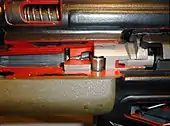
The G3 is a selective-fire automatic weapon that employs a roller-delayed blowback operating system. The two-piece bolt assembly consists of a breech (bolt head) and bolt carrier. The bolt is held in battery by two sliding cylindrical rollers that engage locking recesses in the barrel extension. The breech is opened when both rollers are compressed inward against camming surfaces driven by the rearward pressure of the expanding gases upon the bolt head. As the rollers move inward, recoil energy is transferred to the locking piece and bolt carrier which begin to withdraw while the bolt head slowly moves rearward in relation to the bolt carrier. As the bolt carrier clears the rollers, pressure in the bore drops to a safe level, the bolt head is caught by the bolt carrier and moves to the rear as one unit, continuing the operating cycle. Based on the geometric relationship arising from the angles of the roller contact surfaces of the locking piece and the barrel extension recesses, the recoil of the bolt head is delayed by a ratio of 4:1 for the 7.62×51mm NATO chambering. Thus during the same period of time, the bolt head carrier moves 4 times faster than the bolt head. This ratio is continued until the locking rollers have been withdrawn from the barrel extension recesses. The bolt features an anti-bounce mechanism that prevents the bolt from bouncing off the barrel's breech surface. The "bolt head locking lever" is a spring-loaded claw mounted on the bolt carrier that grabs the bolt head as the bolt carrier group goes into battery. The lever essentially ratchets into place with friction, providing enough resistance to being re-opened that the bolt carrier does not rebound. The spring-powered claw extractor is also contained inside the bolt while the lever ejector is located inside the trigger housing (actuated by the recoiling bolt).[7]
Features


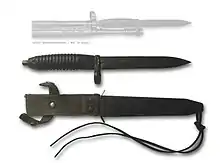
The G3 is a modular weapon system. Its butt-stock, fore-stock and pistol-grip/fire-control assembly may be changed at will in a variety of configurations (listed below). Simple push-pins hold the components in place and removing them will allow the user to remove and replace parts rapidly. The weapon made extensive use of cost-saving pressed and stamped steel components rather than machined parts and spot welding to connect parts. The stamped sheet metal cocking handle tube and receiver are large exposed parts that are prone to deformation from hard impact as they were designed to be relatively thin to save weight. If dented severely or deep enough during field service, reliability problems due to internal parts movement impairments can occur that put the rifle out of action and can not be field solved by the user. To determine and correct such situations armorers are trained to employ specially designed “GO” and symmetry gauges and straightening mandrels to fairly quickly repair such problems.[10][11]
Trigger
The rifle is hammer fired and has a trigger mechanism with a 3-position fire selector switch that is also the manual safety toggle that secures the weapon from accidentally discharging (fire selector in the "E" or "1" position – single fire mode (Einzelfeuer), "F" or "20" – automatic fire (Feuerstoß), "S" or "0" – weapon is safe (Sicher), trigger disabled mechanically). The weapon can be fitted with an optional four-position safety/fire selector group illustrated with pictograms with an ambidextrous selector lever. The additional, fourth selector setting enables a three-round burst mode of fire.[7] The rifle has a relatively high trigger pull of 50–55 N (11.2–12.4 lbf) due to a drop safety requirement. An interchangeable set-trigger pack assembly featuring a trigger stop and less trigger pull is available for the G3SG/1 and other sniping orientated variants.
Sights
The original G3 and G3A1 rifle variants had a relatively low iron sight line that consisted of a Klappvisier a "L-type" flip up rear sight and hooded front post. From the G3A2 variant the firearm is equipped with a relatively low iron sight line that consists of a Drehvisier a rotary rear drum and hooded front post. The rear sight is mechanically adjustable for both windage and elevation with the help of tools. This deliberately prevents non-armorers to (re)zero the iron sight line. The rotary drum features an open V-notch (numbered 1) for rapid target acquisition, close range, low light and impaired visibility use and three apertures (numbered 2, 3 and 4) used for: 200–400 metres (219–437 yd) in 100 metres (109 yd) increments for more precise aiming.[7] The 1 V-notch and 2 or 200 metres (219 yd) aperture settings have an identical point of aim. The V-notch and apertures are calibrated for US M80 / German DM111 series or other equivalent 9.5 grams (147 gr) 7.62×51mm NATO ball ammunition. The receiver housing has recesses that work with STANAG claw mounts/HK clamp adapters used to mount day or night aiming optics.
Barrel
The rifled barrel - four right-hand grooves with a 305 mm (12.0 in) twist rate - terminates with a slotted flash suppressor which can also be used to attach a bayonet or serve as an adapter for launching rifle grenades. From the G3A3 the barrel was free floated from the stock and had polygonal rifling.[12] The barrel chamber is fluted with twelve flutes, which assists in the initial extraction of a spent cartridge casing (since the breech is opened under very high barrel in internal cartridge case pressure).[7]
Feeding
The G3A3 (A4) uses either steel (260 g) or aluminium (140 g) 20-round double-stacked straight box magazines, or a 50-round drum magazine. H&K developed a prototype plastic disposable magazine in the early 1960s, but it was not adopted as aluminum magazines were just as light and proved more durable, as well as easier to produce.
Accessories
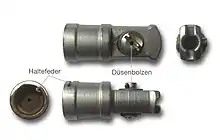
Standard accessories supplied with the rifle include: a detachable bipod (not included with rifles that have a perforated plastic handguard), sling, cleaning kit and a speed-loading device. Several types of bayonet are available for the G3, but with few exceptions they require an adapter to be inserted into the end of the cocking tube. The most common type features a 63⁄4 inch spear-point blade nearly identical with the M7 bayonet, but with a different grip because of its mounting above the barrel. The weapon can also mount a 40 mm HK79 under-barrel grenade launcher, blank firing adapter, a straight blowback bolt (called a "PT" bolt, lacks rollers) used for firing 7.62×51mm ammunition with plastic bullets, a conversion kit used for training with .22 Long Rifle ammunition and a sound suppressor (that uses standard ammunition).
Variants


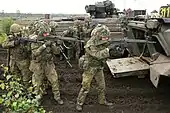
The G3 served as a basis for many other weapons, among them: the PSG1 and MSG90 precision rifles, the HK11 and HK21 family of light machine guns, a semi-automatic version known as the HK41, a "sporterized" model called the SR9 (designed for the civilian market in countries where the HK91 would not qualify, primarily the US after the 1989 importation restrictions) and the MC51 carbine.
- G3: Original model based on the CETME Model 58 introduced in 1959 and approved in 1960. It had a wooden stock and handguard.
- G3A1: G3 approved in 1963 with a single-position, retractable stock sliding in grooves pressed in the sides of the body, locked by a catch under the special bodycap. This design was chosen after earlier experimentation with an MP-40 style ventrally-folding metal stock; excessive recoil caused it to be dropped from consideration.
- G3A2: G3 developed in 1962 with new rotating drum rear sight and a Freischwinger (FS) free-floating barrel that significantly improved accuracy.
- G3A3: The most well known 1963 version. Drum sights with an improved front sight, a flash-suppressor/muzzle brake capable of firing NATO standard grenades, a fixed solid plastic buttstock, and a plastic handguard that does not contact the free-floating barrel. The handguard came in a slim, ventilated version and a wide version. The latter allows for the attachment of a bipod.
- G3A3A1: This is a version of the G3A3 with an ambidextrous trigger group and brass deflector. This is an official German Army designation, not an HK factory one.
- G3A4: The G3A4 uses drum sights and a single position, retractable stock. Entered service in 1974 for frontline infantry units.
- G3A4A1: This is a variant of the G3A4 with an ambidextrous trigger group and brass deflector. This is an official German Army designation, not an HK factory one.
- G3KA4: Smallest of the line, it is a Karabiner, or carbine version of the G3. It uses an HK33 handguard, features drum sights, a retractable stock, and a 315 mm (12.4 in) barrel (reduced in length to the base of the front sight post), that is too short for use with a bayonet or rifle grenades.[7]
- G3KA4A1: Variant of the G3KA4 with a polymer grip assembly, ambidextrous trigger group and brass deflector. This is an official German Army designation, not an HK factory one.
Models made under license
The G3 rifle is or was produced under license in the following countries: Brazil, Iran, France, Greece, Norway, Mexico, Myanmar, Pakistan, Portugal, Saudi Arabia, Sweden and Turkey.
- G3P3: Model number for Pakistani-made version of G3A3.
- G3P4: Model number for Pakistani-made version of G3A4.
- G3A5: HK assigned model number for the HK-made Danish version of the G3A3. It differs in that it has a silent bolt-closure device. In Danish service it is known as the Gv M/66. The Gv M/66 was originally intended for use with optics as a designated marksman rifle, while the rest of the squad were issued M1 Garands.
- G3A6: HK assigned model number for the Iranian-made version of the G3A3. It differs in having a dark-green handguard, stock, and trigger pack.
- G3A7: HK assigned model number for the Turkish-made version of the G3A3.
- G3A7A1: HK assigned model number for the Turkish-made version of the G3A4.
- HSG1: HK assigned model number for the Luxembourg-made version of the G3A3.
- BA63: Model number for Myanmar-made version of original G3 (with wooden stock, handguard and flip sight) [13]
Denmark
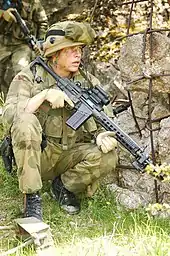
- Gv M/75: Variant leased from the German Bundeswehr / German government by the Danish government to replace the aging M1 Garands. Originally manufactured by either Rheinmetall or HK for the German Bundeswehr. The Gv M/75 rifles are basically G3's with the old style straight cocking tube as opposed to the later FS (Freischwinger, "Cantilevered") variant. The Rheinmetall versions lack an external selector lever and can be converted from semi-automatic to full automatic (or vice versa) by the use of a special tool.
Myanmar
- BA63 (Burma Army):[14] Licensed produced G3 by Myanmar stated owned KaPaSa factories in partnership with Fritz Werner Industry Ausrustungen-Gmbh (FRG) and the German Technical Corporation Agency[15][16] with licensing rights sold by 1960 with the first 10,000 G3s bought from West Germany (through Rheinmetall) before Burmese factories went operational due to fears that it could align with East Germany.[17] It was the main battle rifle for Myanmar armed forces until they were replaced by MA series 5.56mm assault rifles in 1995. The BA63 is still in service with Myanmar Police Force, People's Militia and ethnic Border Guard Forces.[16]
- BA64: Typically known as the G4 in Myanmar armed forces,[14] this is the heavy barreled light machine gun (LMG) version of standard G3A3 with bipod, carrying handle and full metal hand-guard with ventilation ports. Produced by KaPaSa factories in partnership with Fritz Werner Industry Ausrustungen-Gmbh (FRG).[15] As standard, a pair of G4s were issued to every infantry squad in the Myanmar Army. It has now been phased out from in favour of the MA series light machine guns. The BA64 remained in service with Myanmar Police Force, People's Militia and ethnic Border Guard Forces.[16]
- BA72: Assault carbine version of G3A4/G3K with shorter barrel and wooden stock.[15][16]
- BA100: A copy of the G3A3ZF sniper rifle.[15][16]
Norway
- AG-3: Norwegian G3A5 variant produced by Kongsberg Våpenfabrikk, with the given name Automatgevær 3. A total of 253,497 units were produced for the Norwegian Armed Forces from 1967 to 1974. The Norwegian AG-3 differs from the original G3; it has a buttstock that is approx. 2 cm longer, the bolt carrier has a serrated thumb groove to aid in silent bolt closure, it features an all-metal cocking handle and a different bayonet mount. Throughout Autumn 2020, the Norwegian home guard began to replace the AG-3 with the Heckler & Koch HK416 and MP7, a transition which is planned to see completion by the end of the year.[18]
- AG-3F1: An AG-3 with a retractable stock as on G3A4. Produced by Kongsberg Våpenfabrikk. A retractable stock was required by certain groups of soldiers within the Norwegian Armed Forces, primarily vehicle crews with limited space inside, particularly where a quick disembarkment from such a vehicle is required. All versions of the AG-3 have the ability to attach a 40 mm HK79 grenade launcher.
- AG-3F2: An improvement of the AG-3F1, featuring B&T Picatinny rails on the receiver, as well as a RIS handguard. On the AG-3F2, Aimpoint red dot sights were mounted onto the receiver top rail for faster quick acquisition, and easier aiming in low-light conditions.
Sweden

- Ak 4: Swedish-made version of the G3A3, with a buttstock that is 2 cm longer, the bolt carrier has a serrated thumb groove to aid in silent bolt closure and fitted with a heavy buffer for higher number of rounds fired before failure. The iron sights feature extended 200–500 metres (219–547 yd) sight adjustments in 100 metres (109 yd) increments, because the 500 metres (547 yd) hit probability met Swedish military doctrine.[19] The rifles were manufactured from 1965 to 1970 by both Carl Gustafs stads gevärsfaktori and Husqvarna Vapenfabriks and from 1970 until the end of production in 1985 – exclusively by Carl Gustaf in Eskilstuna. All Ak 4's are adapted to mount the M203 grenade launcher. Sweden has supplied unmodified Ak 4's to Estonia, Latvia and Lithuania.
- Ak 4OR: Optiskt Riktmedel, optical sight. This model is fitted with a Hensoldt 4×24 telescopic sight mounted via a HK claw mount. During a few years it was not issued but it is now again in use by the Hemvärnet - Nationella skyddsstyrkorna ("Swedish Home Guard").
- Ak 4B: In this updated version the iron sights have been removed and replaced with an Aimpoint CS red-dot reflex sight mounted on a Picatinny rail. The rail is welded onto the rifle. Used by Hemvärnet - Nationella skyddsstyrkorna ("Swedish Home Guard").
- Ak 4C: An updated version of the Ak 4B with an adjustable-length stock designed and manufactured by the Swedish company Spuhr i Dalby AB. Fielded in 2017 and used by Hemvärnet - Nationella skyddsstyrkorna ("Swedish Home Guard").
- Ak 4D: An updated version of the Ak 4B with the adjustable-length stock of the Ak 4C but with the addition of a modular handguard (also designed and manufactured by the Swedish company Spuhr i Dalby AB) and the Hensoldt 4×24 telescopic sight of the Ak 4OR in a Picatinny mount. The Ak 4D will be used by the Swedish Army as a stop-gap DMR.
Iran
- DIO G3-A3 Bullpup: Iranian bullpup variant of the G3.
Pakistan
- G3P4: Pakistan Ordnance Factories designation for license-produced G3A4 rifles.
- G3S: A version of G3P3 with a shorter barrel.
- G3M-Tactical: A light weight version of G3 rifle with polymer body and shorter barrel.
United Kingdom
- FR Ordnance MC51 Machine Carbine: Produced by the United Kingdom firm FR Ordnance International Ltd.[20] The MC51 weighs 3.1 kg (6.8 lb), has a folded overall length of 625 mm (24.6 in), a barrel length of only 230 mm (9.1 in), which produces a muzzle velocity of approx. 690 m/s (2,263.8 ft/s) and a muzzle energy of 2215 J.[20] Another UK-based company called Imperial Defence Services Ltd. absorbed FR Ordnance and continues to market the MC51 standard variant.[20]
Specialized G3 types
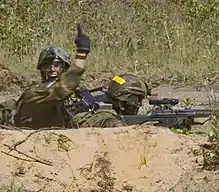
.jpg.webp)
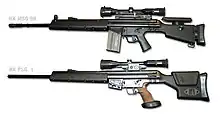
- G3TGS: This is simply a G3 with a 40 mm HK79 under-barrel grenade launcher. TGS stands for Tragbares Granat System ("portable grenade system").
- G3A3ZF: This is a rifle issued with a STANAG claw-and rail scope bracket and a Hensoldt Fero Z24 4×24 telescopic sight to be mounted and zeroed by the user. The ZF stands for Zielfernrohr ("Telescopic Sight"). The Hensoldt Fero Z24 4×24 telescope sight for G3 rifle and claw mount assembly were developed for designated marksman use. The Fero Z24 elevation knob features Bullet Drop Compensation (BDC) settings for 100–600 metres (109–656 yd) in 100 metres (109 yd) increments calibrated for 7.62×51mm NATO ball ammunition.[21] The G3A3ZF is otherwise a standard G3A3 that during factory test shooting printed a 5-shot group of 80 millimetres (3.1 in) (0.8 mil/2.75 MOA) diameter or less.
- G3SG/1: A modified/accurized rifle for sharpshooter/sniper use introduced in 1972. The "SG" stands for Scharfschützengewehr ("Sharpshooting Rifle"). The rifles were individually selected from the G3 production line for outstanding accuracy during test-firing and then modified. G3SG/1 rifles got a heavy, dual-stage buffer, fixed mounted, Zeiss Diavari-DA 1.5-6×36 power telescopic sight and STANAG claw mount assembly mounted. The standard trigger was exchanged for an adjustable set-trigger pack assembly with a 25 N (5.6 lbf) trigger pull and 12.5 N (2.8 lbf) in the set operation mode, the buttstock has a slightly adjustable auxiliary cheek riser, and the lengthened handguard has an integrated bipod. The Zeiss Diavari-DA 1.5-6×36 was windage adjustable and had an elevation knob featuring Bullet Drop Compensation (BDC) settings for 10–600 metres (11–656 yd). For the sub 100 metres (109 yd) ranges the BDC numbers are yellow. The BDC numbers for the longer ranges are white and in 100 metres (109 yd) increments.[22][23][24] The automatic fire mode was retained but the set-trigger mode could only be used for semi-automatic firing.[25]
- MSG3: A variant introduced in 1988 featuring a 600 millimetres (23.6 in) long barrel, a newer telescopic sight mount that is found on only a few of the Heckler & Koch rifles, as compared to the more conventional claw mounts, though the claw mounting points remain on the receiver. This newer telescopic sight mount does not allow the use of the open sights with the mount in place, as is the case with the more conventional claw mount. The receiver is not strengthened. In addition to the G3SG/1 the buttstock has an auxiliary cheek riser and its length is adjustable and features the PSG1 semi-automatic only trigger pack. MSG stands for Militärisches Scharfschützen Gewehr ("Military Sniper Rifle").
- MSG90: A somewhat cheaper and lighter 600 millimetres (23.6 in) long barrel version of the PSG1 modified for military sniping/designated marksman applications. The MSG90 and PSG1 have different trigger packs.
- PSG1: A free-floating 650 millimetres (25.6 in) long barrel semi-automatic only version of the G3 introduced in 1985 with a strengthened receiver with rails welded over the channels where a retractable buttstock would slide and numerous other upgrades and such to meet the necessities of police sniper units. This rifle is famous for its accuracy and comfort, but infamous for its price and inability to be deployed by military units because some upgrades made the rifle too fragile. PSG stands for Präzisionsscharfschützengewehr ("Precision Sniper Rifle").
- HK32: An experimental variant of the rifle chambered for the Soviet 7.62×39mm M43 cartridge. It was never adopted by any country.[26]
Law enforcement and civilian models


- G3A1*: The terminology used by custom gunsmiths (e.g., Choate) and importers (e.g., Interarms) for imported semi-automatic G3 weapons with an aftermarket side-folding stock. This is not part of official HK nomenclature.
- HK41: The HK41 is a semi-automatic version of the G3 that was marketed to law-enforcement. Limited sales at home and US import restrictions and firearms regulations led this weapon to be dropped from HK's product line quickly and it was replaced by the HK91.
- Fleming Arms HK51: Contrary to popular belief, the HK51 is not made by H&K, being a creation of the American Class II manufacturing after-market. The HK51 has no real standards, but is usually a cut down and modified G3A3, or its semi-automatic clones the HK41 and HK91, modified to take MP5 furniture and accessories. It is usually fitted with a collapsible stock; with a 211 mm (8.31-inch) long barrel; it is relatively small at 589 mm (23.17 inches) with the stock retracted and 780 mm (30.72 inches) with the stock extended. The first commercial version was by Bill Fleming of Fleming Arms and existed before Heckler & Koch made the HK53.
- HK91: The HK91 is a semi-automatic version of the G3 similar to the HK41, also marketed to civilians. However, in order to comply with US firearm regulations a number of modifications to the HK91 were made that do not appear on the first pattern HK41. Internal parts that could allow fully automatic fire were removed. A shelf was welded onto the receiver where the push-pin of the trigger pack would normally go, to prevent installation of a fully automatic trigger pack. This did not allow the use of the paddle style magazine release and so the magazine release button on the right side of the magazine well must be used instead. It is otherwise identical to the G3A3/A4. Importation into the United States began in 1974 and ceased in 1989, with some 48,000 rifles being imported.
- HK911: The HK911 was an HK91A2 with the flash hider removed and the receiver re-stamped with an extra 1 to comply with the US importation ban of 1989. The new designation theoretically made it legally immune to the Import Ban, as no "HK911" rifles were mentioned on the list of banned guns. However, the later banning of several "paramilitary" features on the HK911 made it illegal.
- SR9: These variants of the HK91ZF were created to comply with the Semi-Auto Import Ban of 1989, which included all variants of the HK91. They differed from the HK91 in that they had their flash hiders removed and featured a smooth forend that lacked the bipod attachment point. The SR9 series were banned from importation to the United States because they could accept standard-capacity magazines. The SR9 was an HK91A2ZF with the pistol grip and buttstock replaced with a one-piece thumbhole stock.
- SR9 (T): The (T), or "Target", model was an HK91A2ZF with the trigger replaced with the PSG-1 model, the pistol grip replaced with an ergonomic PSG-1 grip and the buttstock replaced with an MSG90 model.
- SR9 (TC): The (TC), or "Target Competition", model was an HK91A2ZF with the trigger group, pistol grip and buttstock derived from the PSG-1.
Other manufacturers
- PTR Industries 91 Series: PTR Industries is manufacturing semi-automatic copies of the HK G3 called the PTR 91.[27] They use tooling from the FMP arms factory in Portugal to build the rifles.[28]
- Century International Arms: Century Arms builds a clone of the CETME C (similar to a G3) under the designation C308.[29]
- SAR-3: Semi-automatic copy of the HK-91 made by EBO in Greece and imported into the United States by Springfield Armory.[30][31]
- Schwaben Arms: Civilian clones for the German market called M41.[32]
- MKE: MKEK made a clone known as the T41.[33]
- LuxDefTec: Luxembourgish clones of the G3 designated HSG41.[34]
Users

Active
 Afghanistan: Iranian and Turkish-made G3s[35][36]
Afghanistan: Iranian and Turkish-made G3s[35][36] Angola[37]
Angola[37] Argentina: Grupo Halcón (Buenos Aires Police Special Operations Group)[38]
Argentina: Grupo Halcón (Buenos Aires Police Special Operations Group)[38] Bahrain[37]
Bahrain[37] Bangladesh: G3A3, G3A4 & G3/SG-1 variants are in service.[37]
Bangladesh: G3A3, G3A4 & G3/SG-1 variants are in service.[37] Brazil:G3A3, G3A4 and G3SG1 used by special forces. G3A4 and G3SG1 used by police forces. G3SG1 used by BOPE. [39][40]
Brazil:G3A3, G3A4 and G3SG1 used by special forces. G3A4 and G3SG1 used by police forces. G3SG1 used by BOPE. [39][40] Bahrain[37]
Bahrain[37].svg.png.webp) Bolivia[37]
Bolivia[37] Botswana[41]
Botswana[41] Brunei[37]
Brunei[37] Burkina Faso:[37] French-made G3s[42]
Burkina Faso:[37] French-made G3s[42] Burundi[37]
Burundi[37] Cameroon[37]
Cameroon[37] Chad[37]
Chad[37] Central African Republic[43]
Central African Republic[43] Chile[37]
Chile[37] Colombia:[37] Originally in 1975, Heckler and Koch sold to Indumil the manufacturing license for the G3, the MP5 submachine gun, and the HK21 machine gun. Replaced in service by IMI Galil.
Colombia:[37] Originally in 1975, Heckler and Koch sold to Indumil the manufacturing license for the G3, the MP5 submachine gun, and the HK21 machine gun. Replaced in service by IMI Galil. Republic of Congo: Used by Cocoye militia during Congo Civil War[44]
Republic of Congo: Used by Cocoye militia during Congo Civil War[44] Côte d'Ivoire:[37] French-made G3s[42]
Côte d'Ivoire:[37] French-made G3s[42] Croatia[37]
Croatia[37] Cyprus[37]
Cyprus[37] Djibouti[37]
Djibouti[37] Dominican Republic[37]
Dominican Republic[37] El Salvador[37]
El Salvador[37] Estonia: Uses the Ak4 and AG-3F2 variant.[45]
Estonia: Uses the Ak4 and AG-3F2 variant.[45] Ethiopia[46]
Ethiopia[46] Gabon:[37] French-made G3s[42]
Gabon:[37] French-made G3s[42] A Bundeswehr G3 fitted with a FERO-Z51 night vision optic
A Bundeswehr G3 fitted with a FERO-Z51 night vision optic Germany: Used by the German Army from the 1950s until the mid-1990s as the primary service rifle.[47] Originally to be replaced by the HK G41 and HK G11, post-reunification budget cuts forced the procurement of the HK G36 instead. Large numbers still in storage, and is used in overseas deployments as a designated marksman rifle. Some variants still in use by border guards and police forces.[37]
Germany: Used by the German Army from the 1950s until the mid-1990s as the primary service rifle.[47] Originally to be replaced by the HK G41 and HK G11, post-reunification budget cuts forced the procurement of the HK G36 instead. Large numbers still in storage, and is used in overseas deployments as a designated marksman rifle. Some variants still in use by border guards and police forces.[37] Ghana[37]
Ghana[37] Greek soldiers in NBC gear with Greek-made G3s
Greek soldiers in NBC gear with Greek-made G3s Greece: The HK G3A3 replaced the American M1 Garand in the late 1970s and manufactured under license by Elliniki Biomihania Oplon (EBO)[48] (now Ellinika Amyntika Systimata (EAS)).[49]
Greece: The HK G3A3 replaced the American M1 Garand in the late 1970s and manufactured under license by Elliniki Biomihania Oplon (EBO)[48] (now Ellinika Amyntika Systimata (EAS)).[49]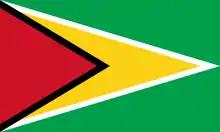 Guyana[37]
Guyana[37] Haiti[37]
Haiti[37] Iceland: AG-3 supplied from Norway[50]
Iceland: AG-3 supplied from Norway[50] Indonesia:[46] TNI-AU (Indonesian Air Force) Special Forces (the Korps Pasukan Khas (Paskhas)) used the G3 as their standard weapon along with the AK-47 since the early 60's during Operation Trikora campaign in Western New Guinea conflict. It was replaced by the Colt M16A3. The G3 is currently used in reserve and training units.
Indonesia:[46] TNI-AU (Indonesian Air Force) Special Forces (the Korps Pasukan Khas (Paskhas)) used the G3 as their standard weapon along with the AK-47 since the early 60's during Operation Trikora campaign in Western New Guinea conflict. It was replaced by the Colt M16A3. The G3 is currently used in reserve and training units. Iran: Manufactured locally by Defense Industries Organization as the G3A6. A bullpup variant is called the G3-A3.[51]
Iran: Manufactured locally by Defense Industries Organization as the G3A6. A bullpup variant is called the G3-A3.[51] Iraq[37]
Iraq[37]
 Kurdistan: 8,000 rifles[52]
Kurdistan: 8,000 rifles[52]
 Ireland[37]
Ireland[37] Jordan[37]
Jordan[37] Kenya[37]
Kenya[37] Latvia: Ak4 variant used by National Guard[37]
Latvia: Ak4 variant used by National Guard[37] Kuwait[53]
Kuwait[53] Lebanon:[37] French-made G3s[42]
Lebanon:[37] French-made G3s[42] Libya[37]
Libya[37] Lithuania: Ak4 variant was used by the Lithuanian Armed Forces[54] and Lithuanian National Defence Volunteer Forces.
Lithuania: Ak4 variant was used by the Lithuanian Armed Forces[54] and Lithuanian National Defence Volunteer Forces. Malawi[37]
Malawi[37] Malaysia: The Malaysian Army and Royal Malaysia Police used the G3A4 as their standard weapon along with HK33 since the early 1970s during Communist insurgency in Malaysia (1968–89). The G3/SG-1 used by the sniper teams of both the military and police special forces. It was replaced by the Colt M16A1. The G3/SG-1 is currently used in reserve and paramilitary units[37]
Malaysia: The Malaysian Army and Royal Malaysia Police used the G3A4 as their standard weapon along with HK33 since the early 1970s during Communist insurgency in Malaysia (1968–89). The G3/SG-1 used by the sniper teams of both the military and police special forces. It was replaced by the Colt M16A1. The G3/SG-1 is currently used in reserve and paramilitary units[37] Mauritania[46] – French-made G3s[42]
Mauritania[46] – French-made G3s[42] Mauritius: Former main battle rifle of the Military of Mauritius. Kept in reserve for training. Still in use in limited amount with the anti-riot police.
Mauritius: Former main battle rifle of the Military of Mauritius. Kept in reserve for training. Still in use in limited amount with the anti-riot police. Mexico:[37] Made under license by Departamento de la Industria Militar, Dirección General de Fábricas de la Defensa, slowly being replaced by the FX-05 Xiuhcoatl
Mexico:[37] Made under license by Departamento de la Industria Militar, Dirección General de Fábricas de la Defensa, slowly being replaced by the FX-05 Xiuhcoatl Morocco[37]
Morocco[37] Pakistani soldier carrying the G3A3 variant after successful Swat Operation at the highest point in the Swat valley on May 12, 2009
Pakistani soldier carrying the G3A3 variant after successful Swat Operation at the highest point in the Swat valley on May 12, 2009 Myanmar[37]
Myanmar[37] Niger:[37] French-made G3s[42]
Niger:[37] French-made G3s[42] Nigeria: Produced under license by Defense Industries Corporation[55]
Nigeria: Produced under license by Defense Industries Corporation[55] Norway: Locally produced variant designated AG-3. In service with Hæren 1968-2008. Largely phased out in Heimevernet, the last few HV-areas to still use it are set to convert to HK416 by the end of 2022.
Norway: Locally produced variant designated AG-3. In service with Hæren 1968-2008. Largely phased out in Heimevernet, the last few HV-areas to still use it are set to convert to HK416 by the end of 2022. Pakistan: Locally produced by Pakistan Ordnance Factories in G3P4 designation[56][57]
Pakistan: Locally produced by Pakistan Ordnance Factories in G3P4 designation[56][57] Papua New Guinea[58]
Papua New Guinea[58] Paraguay[46]
Paraguay[46] Peru[37]
Peru[37] Philippines[46]
Philippines[46] Portugal: Starting in 1962, it was made in Portugal under license by the Fábrica do Braço de Prata. The Portuguese Marine Corps use a modernized version of the G3 with kit Spuhr.[59]
Portugal: Starting in 1962, it was made in Portugal under license by the Fábrica do Braço de Prata. The Portuguese Marine Corps use a modernized version of the G3 with kit Spuhr.[59] Qatar[37]
Qatar[37] Rwanda[37]
Rwanda[37]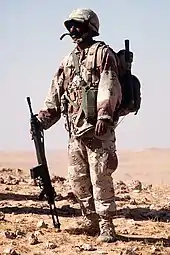 A Saudi Arabian soldier with G3A4 rifle during Operation Desert Shield
A Saudi Arabian soldier with G3A4 rifle during Operation Desert Shield Saudi Arabia:[37] Made under license by the Military Industries Corporation, General Organization for Military Industries in Alkharj[60]
Saudi Arabia:[37] Made under license by the Military Industries Corporation, General Organization for Military Industries in Alkharj[60] Sierra Leone: 8,000 received from the UK and Nigeria during the 1970s and the 1980s. Some Iranian-made G3s have also been recovered.[61]
Sierra Leone: 8,000 received from the UK and Nigeria during the 1970s and the 1980s. Some Iranian-made G3s have also been recovered.[61] Somalia[37]
Somalia[37] Senegal[37][62] – French-made G3s[42]
Senegal[37][62] – French-made G3s[42] Serbia: Used by Special Forces[63]
Serbia: Used by Special Forces[63] South Africa: Used by Special Forces[37]
South Africa: Used by Special Forces[37] Sudan: Made under license by Military Industry Corporation as the Dinar[64]
Sudan: Made under license by Military Industry Corporation as the Dinar[64] Sweden: Made by three manufacturers, Heckler & Koch in Germany, and under license by Husqvarna Vapenfabrik (1965–70) and Carl Gustaf Gevärsfaktori (1965–80) which was later renamed to Förenade Fabriksverken (FFV) as the Ak 4 (Automatkarbin 4).[65] Two sub-variants are known to exist, one equipped with a rail and Aimpoint sight (Ak4 B) and the other with a 4× magnifying optic, the Hensoldt ZF4×24 (Ak 4OR). It has since been replaced by the Ak 5 (Automatkarbin 5; a modified version of the FN FNC) in the regular army. Ak 4B and Ak 4OR, some times in combination with the M203 grenade launcher, is still in use in Hemvärnet – Nationella skyddsstyrkorna ("Swedish Home Guard"). About 5,000 units will receive a new adjustable stock from 2016. In December 2020, Tidningen Hemvärnet announced that every soldier in the Home Guard will receive the new adjustable stock AK4C variant before the end of 2022.[66]
Sweden: Made by three manufacturers, Heckler & Koch in Germany, and under license by Husqvarna Vapenfabrik (1965–70) and Carl Gustaf Gevärsfaktori (1965–80) which was later renamed to Förenade Fabriksverken (FFV) as the Ak 4 (Automatkarbin 4).[65] Two sub-variants are known to exist, one equipped with a rail and Aimpoint sight (Ak4 B) and the other with a 4× magnifying optic, the Hensoldt ZF4×24 (Ak 4OR). It has since been replaced by the Ak 5 (Automatkarbin 5; a modified version of the FN FNC) in the regular army. Ak 4B and Ak 4OR, some times in combination with the M203 grenade launcher, is still in use in Hemvärnet – Nationella skyddsstyrkorna ("Swedish Home Guard"). About 5,000 units will receive a new adjustable stock from 2016. In December 2020, Tidningen Hemvärnet announced that every soldier in the Home Guard will receive the new adjustable stock AK4C variant before the end of 2022.[66] Syria – G3A3 and G3A4s used as designated marksman rifle by Republican Guard[67]
Syria – G3A3 and G3A4s used as designated marksman rifle by Republican Guard[67] Tanzania[37]
Tanzania[37] Togo[37]
Togo[37] A Turkish Land Forces officer using G3A7 with Engerek 3+ and T-40 grenade launcher in Northern Iraq
A Turkish Land Forces officer using G3A7 with Engerek 3+ and T-40 grenade launcher in Northern Iraq Turkey: Made under license by Makina ve Kimya Endüstrisi Kurumu (MKEK) ("Mechanical and Chemical Industry Corporation") as the G3A7 and G3A7A1. A local version called the M65 was produced between 1966 and 1983. During the 1980s it was gradually replaced by the M79, a locally produced version of the HK-33 assault rifle.[68]
Turkey: Made under license by Makina ve Kimya Endüstrisi Kurumu (MKEK) ("Mechanical and Chemical Industry Corporation") as the G3A7 and G3A7A1. A local version called the M65 was produced between 1966 and 1983. During the 1980s it was gradually replaced by the M79, a locally produced version of the HK-33 assault rifle.[68] Uganda[37]
Uganda[37] Ukraine: Undisclosed quantity of Portuguese-made G3A3/4s sent by Portugal as part of a military package in response to the 2022 Russian invasion of Ukraine.[69]
Ukraine: Undisclosed quantity of Portuguese-made G3A3/4s sent by Portugal as part of a military package in response to the 2022 Russian invasion of Ukraine.[69] United Arab Emirates[37]
United Arab Emirates[37] United Kingdom: Many versions of the G3 were used by the SAS and UKSF like the G3K and MC51. The G3KA4 was designated L100A1 by the British Army.[70]
United Kingdom: Many versions of the G3 were used by the SAS and UKSF like the G3K and MC51. The G3KA4 was designated L100A1 by the British Army.[70] Yemen: Yemeni Republican guard and the Yemeni Special guard.[46]
Yemen: Yemeni Republican guard and the Yemeni Special guard.[46] Zambia[37]
Zambia[37] Zimbabwe[46]
Zimbabwe[46]
Former
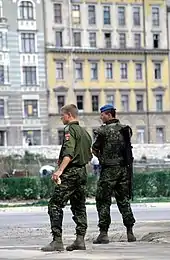 Danish soldiers carrying the G3A5 variant
Danish soldiers carrying the G3A5 variant Denmark: G3A5, as the Gevær Model 1966 (Gv M/66). Another variant, designated Gevær Model 1975 (Gv M/75) was leased from the German government.[46] All G3s in Danish service are being replaced by the Diemaco C7 (Gv m/95), and Diemaco C8 (Gv m/96).
Denmark: G3A5, as the Gevær Model 1966 (Gv M/66). Another variant, designated Gevær Model 1975 (Gv M/75) was leased from the German government.[46] All G3s in Danish service are being replaced by the Diemaco C7 (Gv m/95), and Diemaco C8 (Gv m/96). Georgia: Turkish made G3s used by Special Forces.[71] G3s were also used by Georgian contingent in Kosovo
Georgia: Turkish made G3s used by Special Forces.[71] G3s were also used by Georgian contingent in Kosovo Lesotho[72]
Lesotho[72].jpg.webp) Soldier of the Portuguese Army using an INDEP-made G3A3
Soldier of the Portuguese Army using an INDEP-made G3A3 Portugal:[37] G3A3 and A4 versions. The G3 was the standard-issued rifle of the Portuguese Armed Forces from 1963-2020, manufactured under license by Fábrica de Braço de Prata before it shut down. In 2019, it was announced that it would be replaced by the FN SCAR.[73] The Portuguese Marine Corps still use a modernized version of the G3 with kit Spuhr.[59]
Portugal:[37] G3A3 and A4 versions. The G3 was the standard-issued rifle of the Portuguese Armed Forces from 1963-2020, manufactured under license by Fábrica de Braço de Prata before it shut down. In 2019, it was announced that it would be replaced by the FN SCAR.[73] The Portuguese Marine Corps still use a modernized version of the G3 with kit Spuhr.[59].svg.png.webp) Rhodesia: Portuguese[74] built G3s were used by auxiliary or reserve units of the Rhodesian Security Forces[75][76][77]
Rhodesia: Portuguese[74] built G3s were used by auxiliary or reserve units of the Rhodesian Security Forces[75][76][77].svg.png.webp) South Africa: 100,000 FMP-manufactured surplus G3 rifles were bought from Portugal and designated the R2 Rifle. It was the standard-issue rifle of the South African Marine Corps and South African Air Force, as well within the South West African Territorial Force as a substitute for the R1 Rifle (FN FAL) until it was replaced by the R4 assault rifle in the 1980s[46] The rifle's furniture would soon break down in the heat and become loose, so replacement furniture made of a tough polymer was made by Choate Machine & Tool. The forend had recesses for a bipod's legs and the FAL-style polymer buttstock had a rubber buttplate.[78]
South Africa: 100,000 FMP-manufactured surplus G3 rifles were bought from Portugal and designated the R2 Rifle. It was the standard-issue rifle of the South African Marine Corps and South African Air Force, as well within the South West African Territorial Force as a substitute for the R1 Rifle (FN FAL) until it was replaced by the R4 assault rifle in the 1980s[46] The rifle's furniture would soon break down in the heat and become loose, so replacement furniture made of a tough polymer was made by Choate Machine & Tool. The forend had recesses for a bipod's legs and the FAL-style polymer buttstock had a rubber buttplate.[78].svg.png.webp) Zaire[46]
Zaire[46]
Non-state users
 Democratic Forces for the Liberation of Rwanda (in Democratic Republic of Congo)[79]
Democratic Forces for the Liberation of Rwanda (in Democratic Republic of Congo)[79] Provisional IRA: 100 stolen from Norwegian Reserve base near Oslo, 1984[80]
Provisional IRA: 100 stolen from Norwegian Reserve base near Oslo, 1984[80] ISIL[81]
ISIL[81] Lord Resistance Army[82]
Lord Resistance Army[82]- People's Movement for the Liberation of Azawad[83]
- Revolutionary United Front[84]
- Revolutionary Organization 17 November[85]
Conflicts
1960s
- Internal conflict in Myanmar (1948–present)[86]
- Portuguese Colonial War (1961–1974)[87]
- Papua conflict (1962–present)[88]
- The Troubles (Late 1960s–1998)[89]
- Colombian conflict (1964–present)[89]
- Rhodesian Bush War (1964–1979)[90][91]
- Indo-Pakistani War (1965)[92]
- South African Border War (1966–1990)[89]
- Nigerian Civil War (1967–1970)[93]
- Football War (1969)[94]
1970s
- Bangladesh Liberation War (1971)[95]
- Indo-Pakistani War (1971)[92]
- Turkish invasion of Cyprus (1974)
- Ethiopian Civil War (1974–1991)
- Lebanese Civil War (1975–1990)[96]
- Indonesian invasion of East Timor (1975–1976)
- Nicaraguan Revolution (1978–1990)[97]
- Kurdish–Turkish conflict (1978–present)
- Uganda-Tanzania War (1978-1979)
- Salvadoran Civil War (1979–1992)[97][98]
- Grand Mosque seizure (1979)
1980s
- Iran–Iraq War (1980–1988)[99][100]
- Seychelles coup d'état attempt (1981)[101]
- Second Sudanese Civil War (1983–2005)[102]
- Lord's Resistance Army insurgency (1987–present)[82]
- First Liberian Civil War (1989–1997)
1990s
- Tuareg rebellion (1990–1995)[83]
- Gulf War (1990–1991); saw limited combat use[103]
- Yugoslav Wars (1991–2001)
- Republic of the Congo Civil War (1997–1999)[44]
- Kargil War (1999)[104]
2000s
- War in Afghanistan (2001–2014)[105]
- Iraq War (2003–2011)[103]
- Kivu conflict (2004–present)[79]
- Insurgency in Khyber Pakhtunkhwa (2004–present)
- Mexican Drug War (2006–present)
- Somali Civil War (2009–present)[106]
2010s
2020s
- 2022 Russian invasion of Ukraine[69]
References
- Notes
- Jenzen-Jones 2017, p. 31.
- Woźniak 2001, p. 37
- Jenzen-Jones 2017, p. 24.
- Senich 1987, p. 153
- Senich 1987, p. 158
- Senich 1987, p. 160
- Woźniak 2001, pp. 7–10
- Rheinmetall G3
- Bourne, Mike (2007). Arming Conflict: The Proliferation of Small Arms. Basingstoke: Palgrave-Macmillan. pp. 66–67. ISBN 978-0230019331.
- [The Battele Rifle: Development and Use Since World War II by Russel C. Tilstra, Jefferson, North Carolina : McFarland & Company, Inc., Publishers, 2014.]
- "G3 Armorer's Manual Instructions for Maintenance and Repair Cal. 7.62 mm × 51, page 8" (PDF).
- Walter 2006, p. 164.
- Scarlata, Paul (May 2012). "The military rifle cartridges of Burma/Myanmar". Shotgun News. Archived from the original on 2018-11-28. Retrieved 2018-11-27.
- ""My Gun Was as Tall as Me"". Archived from the original on 2008-10-20. Retrieved 2018-07-25.
- https://www.researchgate.net/profile/Maung_Myoe/publication/272092747_Building_the_Tatmadaw/links/54dac5d50cf2ba88a68de69a/Building-the-Tatmadaw.pdf Archived 2018-07-25 at the Wayback Machine, Page 106.
- "Burmese Small Arms Development". Archived from the original on 2018-07-15. Retrieved 2018-07-25.
- ""Strong and Fast": German Arms in Burma". Archived from the original on 2018-10-05. Retrieved 2018-07-25.
- B, Eric (2020). "Norwegian Home Guard Gets More HK416s and MP7s as AG-3 is Phased Out". The Firearm Blog.
- Kjellgren, G. L. M. "The Practical Range of Small Arms" (PDF). The American Rifleman. pp. 40–44. Archived (PDF) from the original on 5 March 2015.
- "The SAS G3 - Heckler & Koch MC51 -". May 29, 2019.
- "Fero Z24 4×24 telescopic sight for G3 rifle instruction manual" (PDF). Archived (PDF) from the original on 23 August 2016. Retrieved 25 March 2018.
- "Instructions for Use of the Zeiss Diavari-DA 1.5 - 6 Riflescope for the G3 Rifle" (PDF). Archived (PDF) from the original on 23 January 2018. Retrieved 25 March 2018.
- "H&K G3 SG/1, .308 - - Historic Arms Corporation". Archived from the original on 26 March 2018. Retrieved 25 March 2018.
- Administrator. "G3SG1". www.hkpro.com. Archived from the original on 24 January 2018. Retrieved 25 March 2018.
- Walter 2006, p. 165
- Walter, John (2006). The Rifle Story: An Illustrated History from 1756 to the Present Day. MBI Publishing Company. p. 253. ISBN 978-1-85367-690-1. Archived from the original on 2014-01-03. Retrieved 2016-10-15.
- "[SHOT 2020] New PTR-91 HK91/G3 Style .308 Rifles from PTR -". January 29, 2020.
- "HK Tutorial: Build a JLD PTR-91 HK Clone – Arizona Response Systems". www.arizonaresponsesystems.com. Archived from the original on 30 October 2020. Retrieved 6 June 2022.
- "Review: Century Arms C308". 28 May 2015.
- Shelton, Elwood (May 12, 2020). "Greatest Springfield Armory Imports". Gun Digest.
- "Heckler and Koch G3 Battlerifles: Still the main squeeze... overseas (VIDEO)". Guns.com.
- https://www.schwabenarmsgmbh.de/index_htm_files/Testbericht%20Caliber%20Ausgabe%205-2013%20SAR%20M41%20SPORTMATCH%20MF3.pdf
- "New rifle from MKE. MPT-76 in 7,62x51 NATO and the MP5 clones at IWA -". 9 June 2016.
- https://www.waffen-pfandleihhaus.de/beschreibungen/1560.html
- Bhatia, Michael Vinai; Sedra, Mark (May 2008). Small Arms Survey (ed.). Afghanistan, Arms and Conflict: Armed Groups, Disarmament and Security in a Post-War Society. Routledge. p. 65. ISBN 978-0-415-45308-0. Archived from the original on 2018-09-01. Retrieved 2018-09-01.
- Thompson 2019, p. 59.
- Jones, Richard D.; Ness, Leland S., eds. (January 27, 2009). Jane's Infantry Weapons 2009/2010 (35th ed.). Coulsdon: Jane's Information Group. ISBN 978-0-7106-2869-5.
- "División Especial de Seguridad Halcón". Archived from the original on 2012-08-10. Retrieved 2014-11-13.
- "ELITES OF THE EXÉRCITO BRASILEIRO – Small Arms Review". Retrieved 2022-10-19.
- "World Infantry Weapons: Brazil". web.archive.org. 2016-06-02. Retrieved 2022-10-08.
- "Google Sites". sites.google.com. Archived from the original on 24 November 2016. Retrieved 25 March 2018.
- Jenzen-Jones 2017, p. 34.
- Small Arms Survey (2005). "The Central African Republic: A Case Study of Small Arms and Conflict". Small Arms Survey 2005: Weapons at War. Oxford University Press. pp. 309, 318. ISBN 978-0-19-928085-8. Archived from the original (PDF) on 2018-08-30. Retrieved 2018-08-29.
- Small Arms Survey (2003). "Making the Difference?: Weapon Collection and Small Arms Availability in the Republic of Congo". Small Arms Survey 2003: Development Denied. Oxford University Press. p. 274. ISBN 0-19-925175-4. Archived from the original (PDF) on 2018-08-29. Retrieved 2018-08-29.
- "Eesti Kaitsevägi – Tehnika – Automaat AK-4" (in Estonian). Archived from the original on 2008-05-30. Retrieved 2008-07-25.
- Gangarosa, 2001. pp. 76–77.
- Hogg, Ian (2002). Jane's Guns Recognition Guide. Jane's Information Group. ISBN 0-00-712760-X.
- "Personal infantry weapons: old weapons or new hardware in the coming decades?". Archived from the original on 25 September 2013. Retrieved 13 November 2014.
- "eas.gr". Archived from the original on 2012-01-21. Retrieved 2008-06-07.
- ""Sóttu teppi í skotmark hryðjuverkamanna", 'Fréttablaðið', october 27, 2004, p. 12" (in Icelandic). Archived from the original on August 22, 2014. Retrieved October 10, 2011.
- "AIG". Archived from the original on 2012-01-20. Retrieved 2012-01-21.
- Small Arms Survey (2015). "Trade Update: After the 'Arab Spring'" (PDF). Small Arms Survey 2015: weapons and the world (PDF). Cambridge University Press. p. 110. Archived from the original (PDF) on 2018-01-28. Retrieved 2018-08-29.
- Soldier of Fortune. Omega Group, Limited. 2001. p. 46. Retrieved 3 January 2015.
- "Lietuvos kariuomenė :: Ginkluotė ir karinė technika » Automatiniai šautuvai » Automatinis šautuvas AK-4". Archived from the original on 9 October 2014. Retrieved 13 November 2014.
- Nigeria: Arms Procurement and Defense Industries. Archived 2008-12-07 at the Wayback Machine Retrieved on October 5, 2008.
- "Pakistan Army". Archived from the original on 2013-05-13.
- "POF – Automatic Rifle G3A3 & G3P4". Archived from the original on 2013-03-18.
- Capie, David (2004). Under the Gun: The Small Arms Challenge in the Pacific. Wellington: Victoria University Press. pp. 63–65. ISBN 978-0-86473-453-2.
- "Long live the H&K G3! Portuguese NAVY approves the Spuhr upgrade kit -". The Firearm Blog. 2019-06-20. Retrieved 2021-04-17.
- "G3 Automatic Rifle Cal 7.62X51mm". Archived from the original on 2012-12-25. Retrieved 2012-11-29.
- Berman, Eric (December 2000). Re-Armament in Sierra Leone: One Year After the Lome Peace Agreement (PDF). Occasional Paper No. 1. Small Arms Survey. pp. 20, 25. Archived from the original (PDF) on 2018-10-09. Retrieved 2018-09-06.
- Binnie, Jeremy; de Cherisey, Erwan (2017). "New-model African armies" (PDF). Jane's. Archived from the original (PDF) on 22 June 2017.
- "Heckler & Koch G3: Opis" [Heckler & Koch G3: Description] (in Serbian). specijalne-jedinice.com. Archived from the original on 2 February 2017. Retrieved 24 January 2017.
- "Military Industry Corporation (MIC) Official Website". Archived from the original on May 27, 2008.
- "Försvarsmakten". Archived from the original on 2008-05-27. Retrieved 2008-09-06.
- "AK4C till alla hemvärnssoldater" (in Swedish). 21 December 2020. Retrieved 9 June 2021.
- "La 104ème brigade de la Garde républicaine syrienne, troupe d'élite et étendard du régime de Damas". France-Soir (in French). 20 March 2017. Archived from the original on 19 October 2017. Retrieved 4 September 2018.
- "Yerli Tüfek 2014'te Mehmetçik'in elinde". Haber7. 30 September 2014. Archived from the original on 24 September 2015. Retrieved 13 November 2014.
- "Portugal envia equipamento militar: G3, coletes, capacetes e granadas". www.dn.pt (in European Portuguese). Retrieved 2022-04-08.
- "SAS – Weapons – G3 Assault Rifle". eliteukforces.info. Archived from the original on 2013-11-11. Retrieved 2013-10-08.
- "Heckler & Koch HK G3 Assault Rifle / Battle Rifle – Germany". Archived from the original on 22 July 2018. Retrieved 25 March 2018.
- Berman, Eric G. (March 2019). Beyond Blue Helmets: Promoting Weapons and Ammunition Management in Non-UN Peace Operations (PDF). Small Arms Survey/MPOME. p. 43. Archived from the original (PDF) on June 3, 2019.
- "Espingardas G3 do Exército já têm substituta, a belga FN SCAR". Archived from the original on 2019-02-27. Retrieved 2019-03-11.
- Buckles, Vincent (11 June 2015). "The African Rifles: The HK G3 and FN FAL". Firearms News. Archived from the original on 28 September 2018. Retrieved 27 September 2018.
- "The military rifle cartridges of Rhodesia Zimbabwe: from Cecil Rhodes to Robert Mugabe". Archived from the original on 13 November 2014. Retrieved 13 November 2014.
- Peter Bott (1986). Modern African Wars (1) 1965–80. p. 15. ISBN 0-85045-728-9.
- Chris, Cocks (2006) [First published 1988]. Fireforce: One Man's War in the Rhodesian Light Infantry (4th ed.). Covos Day. p. 139. ISBN 978-0-9584890-9-6.
- McCollum, Ian (June 5, 2019). "South African R2 and its Special Furniture". Forgotten Weapons.
- Small Arms Survey (2015). "Waning Cohesion: The Rise and Fall of the FDLR–FOCA" (PDF). Small Arms Survey 2015: weapons and the world (PDF). Cambridge University Press. p. 202. Archived from the original (PDF) on 2018-01-28. Retrieved 2018-08-29.
- "uncovering the Irish republican army". PBS Frontline. 2016-10-19. Archived from the original on 2016-12-12. Retrieved 2016-10-20.
- "How ISIL seized most of its weapons from Iraq military". December 8, 2015. Archived from the original on December 29, 2016. Retrieved November 30, 2016.
- Small Arms Survey (2006). "Fuelling Fear: The Lord's Resistance Army and Small Arms". Small Arms Survey 2006: Unfinished Business. Oxford University Press. p. 283. ISBN 978-0-19-929848-8. Archived from the original (PDF) on 2018-08-30. Retrieved 2018-08-29.
- Small Arms Survey (2005). "Sourcing the Tools of War: Small Arms Supplies to Conflict Zones". Small Arms Survey 2005: Weapons at War. Oxford University Press. p. 166. ISBN 978-0-19-928085-8. Archived from the original (PDF) on 2018-08-30. Retrieved 2018-08-29.
- Wille, Christina (May 2005). "Children Associated with Fighting Forces and Small Arms in the Mano River Union". In Florquin, Nicolas; Berman, Eric G. (eds.). Armed and Aimless: Armed Groups, Guns, and Human Security in the ECOWAS Region. Small Arms Survey. p. 197. ISBN 2-8288-0063-6. Archived from the original (PDF) on 2019-01-31. Retrieved 2019-01-30.
- "November 17's Heavy Arsenal". 12 July 2002 – via Tanea.
- Thompson 2019, p. 43.
- Thompson 2019, pp. 30–31.
- Thompson 2019, p. 44.
- Thompson 2019, p. 29.
- McNab 2002, p. 197.
- Thompson 2019, pp. 32–34.
- "Blog - The G3 Battle Rifle - Osprey Publishing". ospreypublishing.com. Retrieved 2022-10-21.
- McNab 2002, p. 185.
- "Infantry Weapons of the Salvadoran Forces – Small Arms Review". Retrieved 2022-10-18.
- "Arms for freedom". 29 December 2017. Retrieved 2019-08-31.
- Thompson 2019, p. 56.
- Thompson 2019, p. 35.
- McNab 2002, p. 62.
- McNab 2002, p. 137.
- Thompson 2019, pp. 38–41.
- Thompson 2019, p. 32.
- "Sudan – Global trade, local impact: Arms Transfers to all Sides in the Civil War in Sudan" (PDF). Human Rights Watch Report. 10 (4): 24–25. August 1998.
- Thompson 2019, p. 57.
- Thompson 2019, p. 46.
- Thompson 2019, pp. 59–61.
- Thompson 2019, p. 65.
- Jane's infantry weapons, 2009-2010 2009/2010 (35th ed.). Jane's Information Group. 5 January 2009. ISBN 978-0-7106-2869-5.
- Bibliography
- Smith, W.H.B, Small arms of the world : the basic manual of military small arms, Harrisburg, Pa. : Stackpole Books, 1955. OCLC 3773343
- Clinton Ezell, Edward; Small arms of the world, Eleventh Edition, Arms & Armour Press, London, 1977
- (in French) Les fusils d'assaut français "The french assault rifles" by Jean Huon, published by Editions Barnett in 1998, ISBN 2-9508308-6-2.
- Senich, Peter R. (1987). German Assault Rifle: 1935–1945. Paladin Press. ISBN 0-87364-400-X..
- (in German) Günter Wollert; Reiner Lidschun; Wilfried Kopenhagen, Illustrierte Enzyklopädie der Schützenwaffen aus aller Welt : Schützenwaffen heute (1945–1985), Berlin : Militärverlag der Deutschen Demokratischen Republik, 1988. OCLC 19630248
- Gotz, Hans Dieter, German Military Rifles and Machine Pistols, 1871–1945, Schiffer Publishing, Ltd. West Chester, Pennsylvania, 1990. OCLC 24416255
- G. de Vries, B.J. Martens: The MP 43, MP 44, StG 44 assault rifles, Propaganda Photos Series, The Sturmgewehr, Volume 4, Special Interest Publicaties BV, Arnhem, The Netherlands. First Edition 2001.
- Afonso, Aniceto and Gomes, Carlos de Matos, Guerra Colonial, 2000.
- Gangarosa, Gene Jr. (2001). Heckler & Koch—Armorers of the Free World. Maryland: Stoeger Publishing. ISBN 0-88317-229-1.
- Woźniak, Ryszard (2001). Encyklopedia najnowszej broni palnej—tom 2 G-Ł (in Polish). Warsaw, Poland: Bellona. ISBN 83-11-09310-5.
- McNab, Chris (2002). 20th Century Military Uniforms (2nd ed.). Kent: Grange Books. ISBN 1-84013-476-3.
- Walter, John (2006). Rifles of the World, 3rd edition. Oxford: Krause Publications, Inc. ISBN 978-0-89689-241-5.
- Jenzen-Jones, N.R. (January 2017). Global Development and Production of Self-loading Service Rifles: 1896 to the Present (PDF). Working Paper 25. Small Arms Survey. ISBN 978-2-940548-34-7. JSTOR resrep10728. Archived from the original (PDF) on June 29, 2017.
- Thompson, Leroy (30 May 2019). The G3 Battle Rifle. Weapon 68. Osprey Publishing. ISBN 9781472828620.